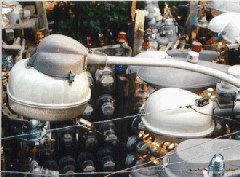
In early 1991 Company A decided to conduct most of their street light conversion efforts on their own, on an overtime basis outside of regular working hours and on Saturdays. So, it was convenient for me to follow their crews around. Some of their utility workers had known me from acquaintances made a few years back at their dumpster; others I introduced myself to and made good friends with. Showing them some photos of my collection and also being an electric utility employee definitely helped attain cooperation from their linemen and supervisors as desired fixtures I had been eyeballing were slated for removal. Like my former dumpster privileges, nobody but another utility employee could ever be granted and have access to these things. Many of the better oldies were General Electric remote ballast 400 watt mercury variations and Wheeler 100 and 175 watt mercury fixtures, all of various glass globe configurations.

MEMORY LANE
I was treated to any of the old stuff and to any of the later cobra style, integral ballast fixtures I had my eye on. I gathered a fair number of various fixture types of this description, most of which were 1960-1966 General Electric M-250 types and Line Materials fixtures of the same vintage; also 100 and 175-watt mercury. Among some of my favorites were the pre-1960 lights and any that I had "grown up" with. The latter were what I refer to as "memory lane" fixtures. These were lights I had lived near, drove or walked under hundreds of times in my earlier years and had simply always remembered as being part of the area I grew up in. What a pleasure it is to own a street light grew up with you! Of sentimental meaning to nobody else but me are the fixtures I always remembered seeing for so many years. These were the exact same lights I passed beneath countless times prior to their removal. Most valued are those that still had the original (never changed!) mercury lamp inside and original photocontrol still on the fixture. In most instances I was right there as my favorite memory lane fixtures were being removed, so these acquisitions were retrieved without a scratch. As the case had been with all of the other mercury luminaries acquired from Company A and other sources, any hazardous materials had to be removed from the fixture before I took possession of it.
Cracking the date code of the fixtures, lamps and photocontrols being removed on site was fun for me and entertaining to the linemen who removed them; especially those who were younger than the fixtures and accessories they were taking down. Almost anyone associated with street lighting engineering will tell you that the fixtures, lamps, photocontrols and ballasts of yesteryear were built to last a long time; primarily those manufactured prior to the early 1970s. Planned obsolescence simply was not in the vocabulary back then. Luminaries and their accessories with such longevity are always a good thing for the collector or user but obviously not for the business of those manufacturing replacement units or parts. It is shameful to see strings of HPS luminaries with dingy refractors, cycling lamps, faulty photocontrols and otherwise serving as birdhouses within just a year or two where there previously had been lights that had served 25-plus years untouched. You can readily see where fixture replacements were already necessary by noticing a shiny gray HPS among their fading gray counterparts.
A municipal utility in southeastern Massachusetts still has a high percentage of their 1963 - 1966 175 watt mercury fixtures still in faithful service as of 1998 and a small number of these still have what look like to have their original photocontrol and/or lamp with them! I get a lot of pleasure viewing these, whether day or night. What a testimonial to the sturdiness of street lighting products of the prior decades!